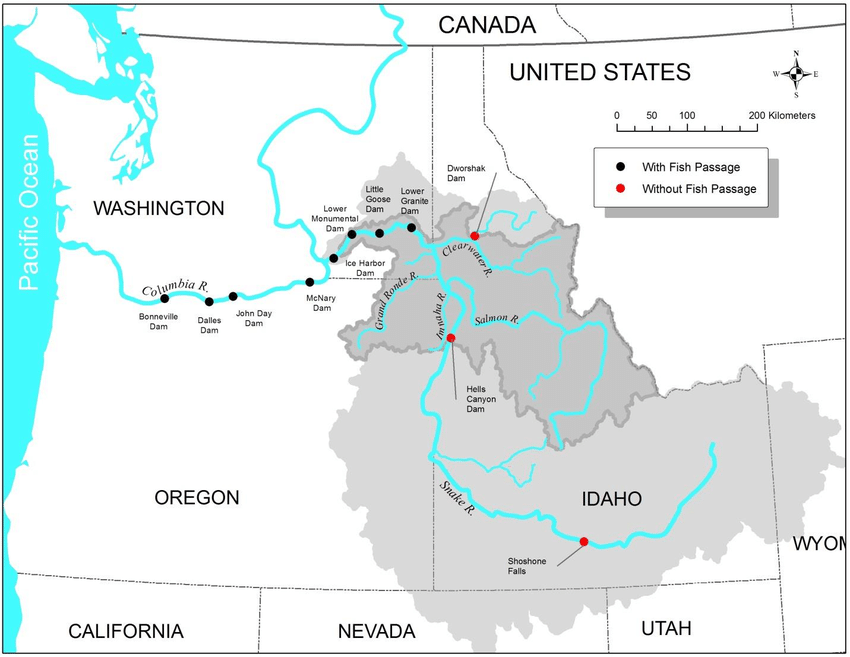Whether the lower Snake River dams should be breached to revive flagging wild salmon and steelhead runs is certainly a top regional issue. And what the impacts would be to the Northwest power supply is a key factor in the breach/no breach debate.
For, against, or undecided, one would want to know with confidence the energy implications of either mothballing these four sources of hydropower or keeping them humming for the foreseeable future.
The lower Snake River dams currently provide about 4 percent of the Northwest’s electricity. With breaching, could that lost power be easily replaced without increasing regional carbon emissions? If not, why not?
The organization with the skills to tell us these answers — to thoroughly, objectively analyze the power supply implications of breaching — is the Northwest Power and Conservation Council.
Indeed, as dam-breaching hovers as a fundamental flash point in Columbia Basin salmon recovery, the Council next week is expected to approve a 20-year power plan for the region. Yet, the draft plan includes no analysis of the power supply implications of knocking the four Lower Snake dams offline.
That’s too bad. In my view, such analysis is what the Council was born to do. Many others feel the same way. Nearly 40 percent of the comments received on the draft plan said, with varying perspectives, that the 20-year power plan should address the power supply implications of Lower Snake River dam breaching.
The Council is at the nexus of salmon recovery and energy production. The power plan, in fact, includes the regional Columbia River Basin Fish and Wildlife Program intended to guide entities charged with mitigating the impacts of federal dams on protected salmonids.
One of the Council’s primary responsibilities, along with developing a fish and wildlife program, is to craft this 20-year power plan for the Pacific Northwest and update it at least every five years. The plan includes an electricity demand forecast, electricity and natural gas price forecasts, an assessment of the amount of cost-effective energy efficiency that can be acquired over the term of the plan, and a “least-cost” resources portfolio.
Much of the plan is basically a prognosis of long-term future energy needs. But the Council’s draft plan, set for final approval next week, avoids the dam-breaching issue.
“There are as yet no planned retirement dates for any mainstem dams on the Snake and Columbia,” says the draft plan. “So, the Council does not need to analyze the effects of the retirement of those plants for this power plan in order to develop the power plan’s new resource strategy and fit that strategy to the existing if changing power system. And it is not the Council’s task under the (Northwest Power) Act, in the power planning process, to analyze or recommend the retirement of existing system resources.”
I get that. Except that it’s a power plan looking 20 years out. A coming twenty years of continued warming waters, less snowpack and, yes, potential extinction of Snake/Salmon River basin wild salmon and steelhead. And the system resource – the Lower Snake River dams – is going to be a flashpoint, one way or another, that entire 20 years.
Even though Council members chose in their draft power plan to proceed with no analysis of the power supply implications of Lower Snake dam removal, it does recognize a need at some point.
“There may be value to the region in having the Council analyze the power system effects of the retirement of those dams,” says the draft plan. “Such an analysis could provide information to decision makers considering the future of the projects. “
Seems to me that time is now. Washington Gov. Jay Inslee and U.S. Sen. Patty Murray have pledged an assessment of whether and how to best replace the benefits of the dams, scheduled to be completed this summer. And the parties involved in litigation over the Columbia River basin Environmental Impact Statement/Biological Opinion for salmon and steelhead are in talks now, with hopes of presenting a collaborative product to the federal court within months. No doubt the lower Snake dams are at the center of those negotiations.
Considering these fast-moving developments, and the fact that energy planning and salmon recovery are inextricably linked in the Columbia River Basin, the Council, built for both power and fish, would be doing the region a service by analyzing how to replace the energy from the lower Snake River dams should they be breached to avoid extinction of wild Snake River basin salmon and steelhead.
— Bill Crampton, [email protected]
Also see:
— CBB, Dec. 16, 2021, SHOULD THE NORTHWEST’S NEW 20-YEAR POWER PLAN INCLUDE ANALYSIS OF LOWER SNAKE DAM REMOVAL? SOME SAY YES, SOME NO https://columbiabasinbulletin.org/should-the-northwests-new-20-year-power-plan-include-analysis-of-lower-snake-dam-removal-some-say-yes-some-no/
— CBB, Sept. 30, 2021, DRAFT POWER PLAN SAYS RELYING MORE ON RENEWABLES COULD IMPACT FLOWS, FISH IN COLUMBIA/SNAKE RIVER; CALLS FOR FURTHER STUDY https://columbiabasinbulletin.org/draft-power-plan-says-relying-more-on-renewables-could-impact-flows-fish-in-columbia-snake-river-calls-for-further-study/
— CBB, Dec. 9, 2021, EDITOR’S NOTEBOOK: AS WE END THE YEAR, BIG DECISIONS FOR COLUMBIA RIVER BASIN SALMON RECOVERY DANGLE ON HOLD https://columbiabasinbulletin.org/editors-notebook-as-we-end-the-year-big-decisions-for-columbia-river-basin-salmon-recovery-dangle-on-hold/

